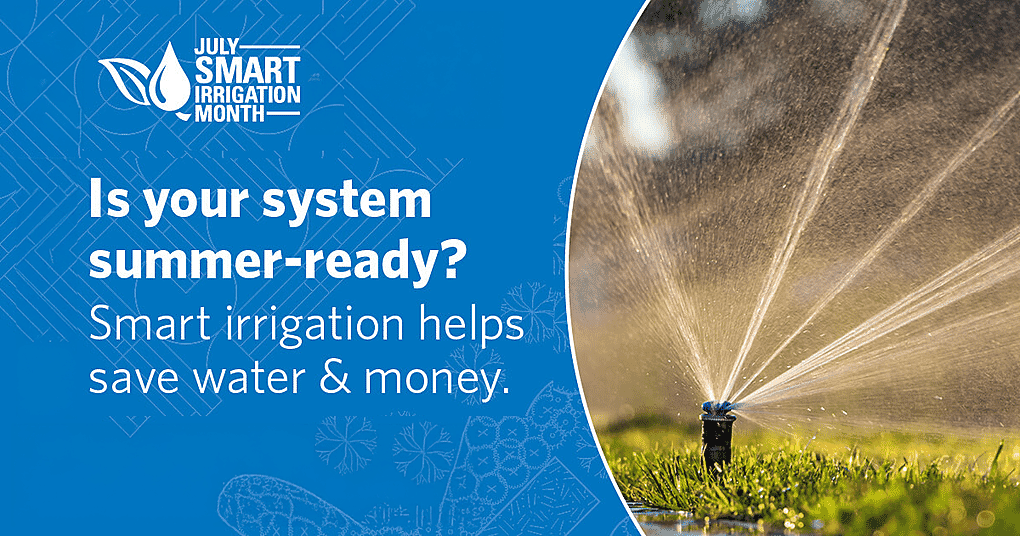Blog
Smarter Watering, Healthier Landscapes: The Sustainable Promise of Smart Irrigation
July is peak irrigation season across much of the country lawns, gardens, and landscapes are thirsty, and homeowners and property managers are running sprinklers full tilt. That’s precisely why the Irrigation Association designates July as Smart Irrigation Month; to spotlight the enormous opportunity we all have to improve how we water.
In a world where water costs are rising, and droughts are hitting harder than ever, being water-wise isn’t just good stewardship. It’s also smart economics. By embracing the principles of smart irrigation, you can protect your landscape, lower your bills, and contribute to a more sustainable future.
What is “smart irrigation”?
“Smart irrigation” is about watering the right amount at the right time with the right tools. It combines technologies such as weather-based controllers, soil moisture sensors, drip systems, and high-efficiency sprinkler heads to ensure landscapes receive precisely what they need, nothing more, nothing less.
Unlike traditional systems that operate on fixed schedules, smart irrigation systems automatically adjust according to local weather conditions, plant needs, and seasonal changes. This means your sprinklers won’t water right after it rains or run unnecessarily long during cooler periods.
The hidden waste in typical irrigation systems
According to the EPA WaterSense program, as much as 50% of outdoor water use is wasted due to inefficiency—think runoff from overwatering, evaporation from poor timing, and water being sprayed on sidewalks and driveways.
The average American household uses more water outside in July than they do inside all year long. That’s a significant strain on local water supplies, especially during peak summer demand.
The benefits of going smart
Embracing smart irrigation offers advantages that go well beyond a smaller water bill:
Healthier landscapes
Plants thrive when they receive consistent, appropriate watering. Overwatering can suffocate roots and promote disease; underwatering leads to stress and brown patches. Smart irrigation systems fine-tune watering so your lawn and garden look vibrant all season.
Lower costs
Using less water means spending less. In many communities, summer irrigation significantly increases utility bills. Smart systems typically reduce outdoor water use by 20-50%, resulting in significant savings throughout the season.
Peace of mind
Are you heading out on vacation? A smart controller continues to adjust watering based on weather—so you won’t come home to a drought-stressed yard or a sky-high bill because your system ran during a rainstorm.
Environmental impact
Water is becoming an increasingly precious resource. Conserving it helps ensure there’s enough to go around, protects local ecosystems, and reduces the energy used to treat and pump water.
Tips for making your irrigation smarter this summer
You don’t have to rip out your existing system to start benefiting from smart irrigation principles. Here’s how to get started this July:
- Upgrade to a weather-based controller. These automatically adjust watering based on temperature, rainfall, humidity, and more. Many local water agencies offer rebates to help cover the cost.
- Fix leaks and adjust heads. A single broken sprinkler head can waste thousands of gallons over the summer. Walk your yard monthly, checking for puddles, geysers, or clogged nozzles.
- Switch to drip where possible. Drip irrigation delivers water directly to the root zone, minimizing evaporation and making it ideal for flower beds, shrubs, and other garden areas.
- Add mulch. A 2-3 inch layer of mulch reduces evaporation, moderates soil temperature, and cuts watering needs by up to 25%.
- Water early. The best time to water is early morning—less wind, less evaporation, and plants are hydrated for the heat of the day.
Join the movement this Smart Irrigation Month
July is the perfect time to evaluate your watering practices. Many local utilities offer free irrigation audits or rebates for upgrading to more efficient technology. Beyond saving money, adopting smart irrigation protects one of our most critical natural resources.
Small changes add up. If every household reduced outdoor watering by even 10%, it would save billions of gallons nationwide. That’s a powerful legacy to leave for the next generation.
So, this Smart Irrigation Month, take a moment to check your system, upgrade your controls, or water more thoughtfully. Your landscape—and your wallet—will thank you.

